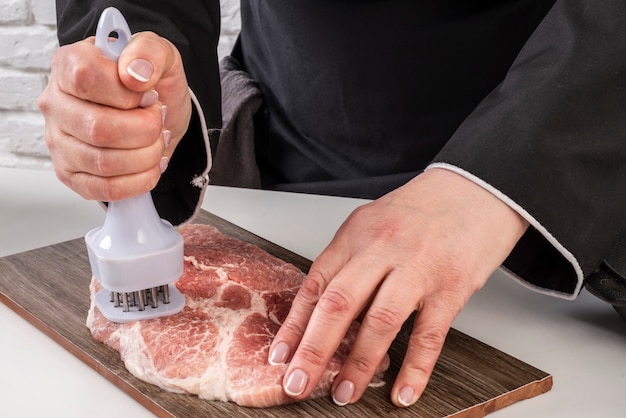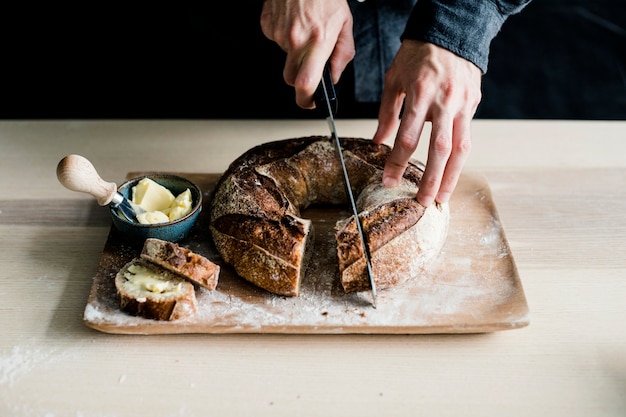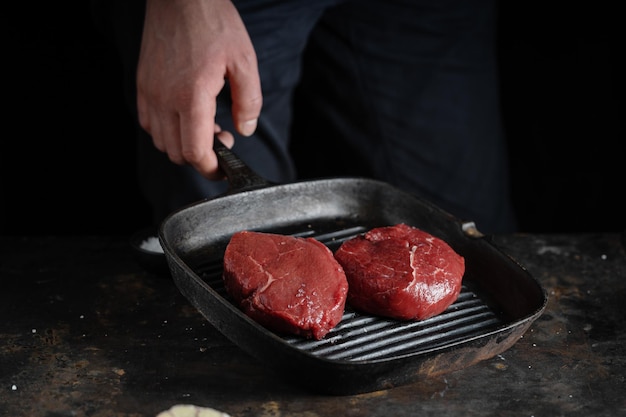(Part 1) The Cut: choosing the right steak

You know, I've learned that choosing the right cut is like picking the perfect outfit for a special occasion - it sets the stage for the whole experience. For a truly delicious medium-rare steak, you want something with enough marbling to stay juicy and tender. Think of it like this: you wouldn't wear a flimsy t-shirt to a fancy dinner, right? You want something that's going to hold its own and make a statement.
The Classics
You can't go wrong with the classics like:
- Ribeye: This one's a real crowd-pleaser. It's known for its generous marbling, rich flavour, and beautifully marbled texture. It's like the steak equivalent of a velvet robe - pure luxury. If you're looking for a steak that's going to impress everyone at the table, this is your go-to choice.
- new york strip: With a distinct, juicy flavour and a nice, even texture, this cut is a real charmer. Think of it like a classic black dress - always elegant and in style. It's a bit more lean than a ribeye, but still delivers a delicious, satisfying flavour.
- Sirloin: This cut is more lean, making it a great option if you prefer a slightly less fatty steak. Think of it as a stylish pencil skirt - streamlined and sophisticated. It's a great choice for those who appreciate a lighter meal but still crave the taste of a great steak.
The More Adventurous
Now, if you're looking for something a little more adventurous, these are some fantastic options:
- filet mignon: This tender, luxurious cut is the epitome of elegance. Think of it as a sophisticated cocktail dress - perfect for special occasions. It's a smaller cut, so it's perfect for a romantic dinner or a special treat.
- Porterhouse: This hefty cut, often weighing in at a whopping 1.5-2 pounds, is perfect for feeding a crowd. Think of it as a statement dress - bold and attention-grabbing. This is a great option if you're having a barbecue or a party and want to impress your guests with a show-stopping steak.
The budget-friendly Picks
Let's be real, sometimes you want that perfect steak without breaking the bank. Here are some budget-friendly options that still deliver a satisfying flavour:
- chuck steak: With a little TLC, this cut can be surprisingly tender and flavorful. It's like a classic denim jacket - comfortable, versatile, and always a good choice. It's often overlooked, but with the right cooking method, chuck steak can be just as delicious as the more expensive cuts.
- flank steak: This lean cut is best for grilling or stir-frying, and it has a fantastic, slightly beefy flavour. Think of it as a cool leather jacket - edgy and distinctive. It's a great option for a quick and easy meal, or for a flavorful addition to a stir-fry.
(Part 2) The Preparation: Getting Your Steak Ready

Right, you've got your cut, now it's time to get it ready for its moment in the spotlight. It's like prepping your stage for a grand performance, and trust me, every detail matters.
Pat It Dry: Avoiding a Soggy Situation
The first step is to pat your steak dry. This is a game-changer. A wet steak will steam instead of sear, leading to a mushy, disappointing finish. Think of it as removing the backstage clutter before the curtain rises - you want your steak to shine, not get lost in a puddle of water. Imagine your steak as a beautiful actor about to step on stage. You wouldn't want them to be drenched in sweat, would you? The same principle applies here.
Give It Some Breathing Room: Let it Rest
Resist the urge to cook it straight from the fridge. Give your steak a chance to come to room temperature (about 30-60 minutes) before cooking. This helps it cook more evenly and prevents a cold, undercooked centre. Think of it as a backstage warm-up for your steak - it needs a chance to get in the zone before the show starts. Just like an athlete needs to warm up before a game, your steak needs time to acclimate to its surroundings before it hits the heat of the grill.
Seasoning: A Touch of Magic
Now, onto seasoning. I keep it simple, but there's a method to the madness. Start with salt and freshly ground black pepper. They're like the foundation of a great performance - they enhance the steak's natural flavours and bring out the best in it.
You can add a pinch of garlic powder, smoked paprika, or even a touch of chili flakes to give your steak a bit of extra oomph. Think of these as the supporting actors in your steak's story - they add depth and complexity.
A little tip: Don't over-season! You want to enhance the steak's flavour, not mask it. A light dusting of salt and pepper is usually all you need.
(Part 3) The Heat: Mastering the Grill

Now, we get to the exciting part - grilling. This is where your culinary creativity shines, so let's talk about how to get that perfect sear and juicy interior.
Heat It Up, Baby!
First things first, crank up that grill. You need a good, hot fire for a perfect sear. It's like the stage lights - they set the mood and draw attention to your steak's star quality.
I typically aim for medium-high heat, around 450-500°F (230-260°C), for a nice, even sear. If you're using charcoal, make sure your coals are nice and white-hot. If you're using gas, make sure all burners are preheated.
Important Note: A hot grill sears the outside of the steak quickly, creating that beautiful crust and locking in the juices. If your grill isn't hot enough, your steak will steam instead of sear, resulting in a soggy, disappointing finish.
The Art of the Sear: Getting That Crust
Now, place your steak on the grill, making sure it has enough space to breathe. Don't crowd the grill - it'll lead to uneven cooking. You want your steak to have a chance to shine, not get lost in a crowded stage.
Let it cook undisturbed for 2-3 minutes per side. This is all about getting that beautiful, caramelized crust. The first kiss of the grill is the most dramatic part of the show - it's about creating that visual wow factor.
Pro Tip: Use tongs to move your steak around on the grill. Avoid using a fork, as it will pierce the steak and allow the juices to escape.
Turning the Tables: Flipping for Success
After searing the first two sides, it's time to flip. Don't worry, it's not as scary as it sounds. Just use your tongs to gently flip the steak and sear the other two sides. This is like adding a new layer to the performance - each turn builds the intensity and keeps the audience engaged.
internal temperature: The Tell-Tale Sign
Now, here's where things get a bit more scientific (but trust me, it's worth it!). You want to make sure your steak reaches the right internal temperature for medium-rare.
For a medium-rare steak, you're aiming for an internal temperature of 130-135°F (54-57°C). This is like the crescendo of the performance - it's the moment where all the elements come together to create a perfect harmony of flavours.
To check the temperature, use a digital meat thermometer. Insert it into the thickest part of the steak, making sure it's not touching any bone. This is like checking your instruments backstage - you want to make sure everything is in tune before you take the stage.
Tip: If you don't have a meat thermometer, you can use the finger test to estimate the doneness of your steak. Press the steak gently with your finger. If it feels firm and springy, it's medium-rare.
(Part 4) The Rest: Letting Your Steak Relax
Alright, you've done all the hard work. Your steak is perfectly seared and has reached the perfect temperature. Now, it's time to let it rest. This is not just about being patient, it's about letting the juices redistribute, creating a more tender and flavorful steak.
Transfer your steak to a cutting board and cover it loosely with foil. Let it rest for 10-15 minutes. This is like giving your steak a backstage breather - it allows it to relax and regain its composure before it's unveiled to the world.
Why Resting is Important: When you remove your steak from the grill, the heat continues to cook it. Resting allows the heat to distribute evenly throughout the steak, creating a more tender and juicy result.
(Part 5) The Slice: A Masterclass in Carving
The moment of truth has arrived. It's time to carve your steak. This is the final act, the grand finale, so let's make it a masterpiece.
Against the Grain: The Key to Tenderness
The most important thing is to cut your steak against the grain. The grain is the direction of the muscle fibres, and cutting against it helps to break them down, making the steak even more tender and easier to chew. Think of it as a dance performance - every move must be carefully choreographed to achieve a seamless, graceful effect.
What is "The Grain"? The grain of a steak refers to the direction in which the muscle fibers run. You can usually see the grain running along the length of the steak.
Thin Slices: Maximizing Enjoyment
Cut your steak into thin slices, about half an inch thick. This allows you to better appreciate the steak's marbling and texture. This is like revealing a piece of art - you want to make sure every detail is visible and can be savoured.
(Part 6) The Sauce: A Touch of Luxury
Okay, your steak is cooked to perfection, sliced beautifully, and resting gracefully. Now, let's add that final touch of magic - the sauce. This is like the grand finale of a symphony - it's the final flourish that elevates the whole experience.
The Classics: Simplicity is Key
For a classic steak sauce, you can't go wrong with a simple red wine sauce or a creamy béarnaise. They're like the classic melodies of the sauce world - familiar, comforting, and always in style.
A Classic Red Wine Sauce: To make a simple red wine sauce, simply deglaze the pan in which you cooked your steak with red wine, then add butter, herbs, and seasonings to taste.
A Creamy Béarnaise Sauce: Béarnaise sauce is a rich, creamy sauce made with egg yolks, butter, vinegar, and herbs. It's a classic accompaniment to steak, but it can also be served with other dishes like fish and vegetables.
Experimenting with Flavors: Embracing the Unexpected
If you're feeling adventurous, try a tangy chimichurri sauce or a spicy sriracha mayonnaise. These are like the avant-garde movements in the sauce world - bold, unexpected, and full of flavour.
Tangy Chimichurri Sauce: Chimichurri sauce is a vibrant, herb-based sauce that originates from Argentina. It's made with parsley, oregano, garlic, olive oil, vinegar, and red pepper flakes.
Spicy Sriracha Mayonnaise: This sauce combines the creamy richness of mayonnaise with the fiery kick of sriracha sauce.
(Part 7) The Sidekicks: A Symphony of Flavors
No steak is complete without its sidekicks. The right sides can really enhance your steak's performance and create a symphony of flavours. Think of them as the supporting cast members - they add depth and complexity to the story.
The Classics: Comfort and Familiarity
You can't go wrong with classic sides like mashed potatoes, roasted vegetables, or a simple green salad. They're like the classic supporting roles in a play - reliable, comforting, and always welcome.
Mashed Potatoes: Mashed potatoes are a classic comfort food that pairs perfectly with steak. They're creamy, flavorful, and easy to make.
Roasted Vegetables: Roasted vegetables are a healthy and delicious side dish for steak. They're easy to prepare, and the roasting process brings out their natural sweetness and flavor.
Simple Green Salad: A simple green salad can help to balance out a rich and flavorful meal like steak. It's a light and refreshing way to cleanse the palate.
The Creative Options: Adding a Twist
For a bit of flair, try something more creative like a creamy risotto, a vibrant coleslaw, or a spicy potato salad. They're like the surprise guest stars in your meal - unexpected, exciting, and memorable.
Creamy Risotto: Risotto is a creamy, Italian rice dish that's often served with cheese and mushrooms. It's a decadent and flavorful side dish for steak.
Vibrant Coleslaw: Coleslaw is a refreshing and crunchy side dish that can add a bit of brightness to your meal.
Spicy Potato Salad: Spicy potato salad is a fun and flavorful twist on a classic side dish. It's made with potatoes, mayonnaise, mustard, and spices.
(Part 8) FAQs: Answering Your Steak-Related Questions
So, you've mastered the art of the perfect medium-rare steak, but you still have a few lingering questions? Don't worry, I've got you covered.
1. Can I Cook My Steak in the Oven?
Absolutely! If you don't have a grill, you can cook your steak in the oven. Preheat your oven to 450°F (230°C). Sear the steak on the stovetop for a couple of minutes on each side, then transfer it to a baking sheet and cook it in the oven until it reaches the desired internal temperature.
2. How Long Should I Rest My Steak?
It's important to rest your steak for 10-15 minutes after cooking. This allows the juices to redistribute, creating a more tender and flavorful steak.
3. What's the Best Way to Freeze Steak?
If you need to freeze your steak, wrap it tightly in plastic wrap and place it in a freezer-safe bag. This will help to prevent freezer burn and keep your steak fresh.
4. How Can I Tell If My Steak Is Done?
The best way to tell if your steak is done is to use a digital meat thermometer. For a medium-rare steak, you're aiming for an internal temperature of 130-135°F (54-57°C).
5. What's the Difference Between a Ribeye and a New York Strip?
A ribeye is known for its generous marbling, rich flavour, and beautifully marbled texture. A New York strip has a distinct, juicy flavour and a nice, even texture. The ribeye is typically more flavorful and tender due to its higher fat content, while the New York strip is a bit leaner and more firm in texture.
(Part 9) The Final Word: A culinary adventure
There you have it, folks - your complete guide to the perfect medium-rare steak. It's not just about cooking meat, it's about creating a culinary adventure, a symphony of flavours, and a moment of pure indulgence. So, go forth, embrace your inner grill master, and enjoy the delicious journey!
Everyone is watching

How to Cook Frozen Lobster Tails Perfectly: A Step-by-Step Guide
RecipesLobster. Just the word conjures up images of lavish meals, special occasions, and a taste of luxury. But let's...

Pigs in a Blanket Cooking Time: How Long to Bake for Perfect Results
RecipesAh, pigs in a blanket. Just the name conjures up images of those delightful little parcels of crispy pastry en...

Pork Fillet Cooking Time: How Long to Cook It Perfectly
RecipesPork fillet, or tenderloin as it's sometimes called, is a real favourite in our house. It's so versatile, and...

The Ultimate Guide to Cooking Delicious Frankfurters
RecipesLet's face it, we all love a good frankfurter. It's a classic, simple, and always satisfying. But let's be rea...

Wolf Meat Recipes: A Guide to Cooking Wild Game
RecipesLet's be honest, you don't see wolf meat at your local butcher shop every day. It's a bit of a wild card, but ...
